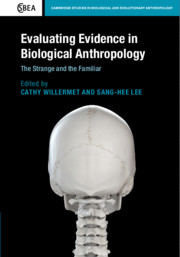Book contents
- Evaluating Evidence in Biological Anthropology
- Cambridge Studies in Biological and Evolutionary Anthropology
- Evaluating Evidence in Biological Anthropology
- Copyright page
- Contents
- Contributors
- Introduction
- Part I The Strange and the Familiar
- Part II (Re)Discovery of Evidence
- 6 (Re)Discovering Paleopathology
- 7 Parsing the Paradox
- 8 Seeing RED
- 9 Paleoanthropology and Analytical Bias
- 10 (Re)Discovering Ancient Hominin Environments
- 11 Discussion and Conclusion
- Index
- References
9 - Paleoanthropology and Analytical Bias
Citation Practices, Analytical Choice, and Prioritizing Quality over Quantity
from Part II - (Re)Discovery of Evidence
Published online by Cambridge University Press: 01 November 2019
- Evaluating Evidence in Biological Anthropology
- Cambridge Studies in Biological and Evolutionary Anthropology
- Evaluating Evidence in Biological Anthropology
- Copyright page
- Contents
- Contributors
- Introduction
- Part I The Strange and the Familiar
- Part II (Re)Discovery of Evidence
- 6 (Re)Discovering Paleopathology
- 7 Parsing the Paradox
- 8 Seeing RED
- 9 Paleoanthropology and Analytical Bias
- 10 (Re)Discovering Ancient Hominin Environments
- 11 Discussion and Conclusion
- Index
- References
Summary
Since the nineteenth century, studies of the human fossil record and human skeletal variation have made scientific rigor a valued goal. In the nineteenth and early twentieth centuries, this manifested itself in the creation of objective standards of measurement and observation (Boas 1899; Hrdlička 1919). More recent attempts have been made to further address the challenges of gathering standardized data from skeletal or fossil samples deriving from different populations, contexts, or taphonomic conditions (Buikstra and Ubelaker 1994). By the early twentieth century, the growth of available metric data required greater attention to the use of quantitative data in formal statistical analyses, often with the aim of explicit hypothesis testing (Morant 1939). Since the 1960s, multivariate statistical approaches have increasingly dominated the quantitative literature in evolutionary studies, accommodating ever-increasing data availability and increased computer processing capabilities (Howells 1969; Sokal and Rohlf 1981).
- Type
- Chapter
- Information
- Evaluating Evidence in Biological AnthropologyThe Strange and the Familiar, pp. 174 - 186Publisher: Cambridge University PressPrint publication year: 2019
References
- 1
- Cited by



